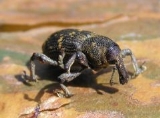
Hylobius abietis
Encyclopedia
Hylobius abietis is a beetle
belonging to the family Curculionidae
(the true weevils). It shares the common name pine weevil with the rarer Hylobius pinastri. This weevil is a common associate of conifers throughout Europe
.
The adult is 10-13 mm in length, dark brown with patches of yellow or light brown hairs arranged in irregular rows. The legs are black or deep red with a distinctive tooth on the femur
. This species is a serious pest
of conifers, especially fir
s, pine
s and spruce
s, causing damage by eating the bark
of young shoots thus preventing further growth. Adults can be found all year although they usually hibernate
during the cold winter months.
The eggs
are laid on the bark of rotting wood, usually tree stumps, the larva
tunnelling into the wood to feed.
Hylobius abietis has the ability of attaching into human skin and wood, when attached into human skin, a heavy pressing is felt.
Beetle
Coleoptera is an order of insects commonly called beetles. The word "coleoptera" is from the Greek , koleos, "sheath"; and , pteron, "wing", thus "sheathed wing". Coleoptera contains more species than any other order, constituting almost 25% of all known life-forms...
belonging to the family Curculionidae
Curculionidae
Curculionidae is the family of the "true" weevils . It was formerly recognized in 1998 as the largest of any animal family, with over 40,000 species described worldwide at that time...
(the true weevils). It shares the common name pine weevil with the rarer Hylobius pinastri. This weevil is a common associate of conifers throughout Europe
Europe
Europe is, by convention, one of the world's seven continents. Comprising the westernmost peninsula of Eurasia, Europe is generally 'divided' from Asia to its east by the watershed divides of the Ural and Caucasus Mountains, the Ural River, the Caspian and Black Seas, and the waterways connecting...
.
The adult is 10-13 mm in length, dark brown with patches of yellow or light brown hairs arranged in irregular rows. The legs are black or deep red with a distinctive tooth on the femur
Femur
The femur , or thigh bone, is the most proximal bone of the leg in tetrapod vertebrates capable of walking or jumping, such as most land mammals, birds, many reptiles such as lizards, and amphibians such as frogs. In vertebrates with four legs such as dogs and horses, the femur is found only in...
. This species is a serious pest
Pest (animal)
A pest is an animal which is detrimental to humans or human concerns. It is a loosely defined term, often overlapping with the related terms vermin, weeds, parasites and pathogens...
of conifers, especially fir
Fir
Firs are a genus of 48–55 species of evergreen conifers in the family Pinaceae. They are found through much of North and Central America, Europe, Asia, and North Africa, occurring in mountains over most of the range...
s, pine
Pine
Pines are trees in the genus Pinus ,in the family Pinaceae. They make up the monotypic subfamily Pinoideae. There are about 115 species of pine, although different authorities accept between 105 and 125 species.-Etymology:...
s and spruce
Spruce
A spruce is a tree of the genus Picea , a genus of about 35 species of coniferous evergreen trees in the Family Pinaceae, found in the northern temperate and boreal regions of the earth. Spruces are large trees, from tall when mature, and can be distinguished by their whorled branches and conical...
s, causing damage by eating the bark
Bark
Bark is the outermost layers of stems and roots of woody plants. Plants with bark include trees, woody vines and shrubs. Bark refers to all the tissues outside of the vascular cambium and is a nontechnical term. It overlays the wood and consists of the inner bark and the outer bark. The inner...
of young shoots thus preventing further growth. Adults can be found all year although they usually hibernate
Hibernation
Hibernation is a state of inactivity and metabolic depression in animals, characterized by lower body temperature, slower breathing, and lower metabolic rate. Hibernating animals conserve food, especially during winter when food supplies are limited, tapping energy reserves, body fat, at a slow rate...
during the cold winter months.
The eggs
Egg (biology)
An egg is an organic vessel in which an embryo first begins to develop. In most birds, reptiles, insects, molluscs, fish, and monotremes, an egg is the zygote, resulting from fertilization of the ovum, which is expelled from the body and permitted to develop outside the body until the developing...
are laid on the bark of rotting wood, usually tree stumps, the larva
Larva
A larva is a distinct juvenile form many animals undergo before metamorphosis into adults. Animals with indirect development such as insects, amphibians, or cnidarians typically have a larval phase of their life cycle...
tunnelling into the wood to feed.
Hylobius abietis has the ability of attaching into human skin and wood, when attached into human skin, a heavy pressing is felt.

